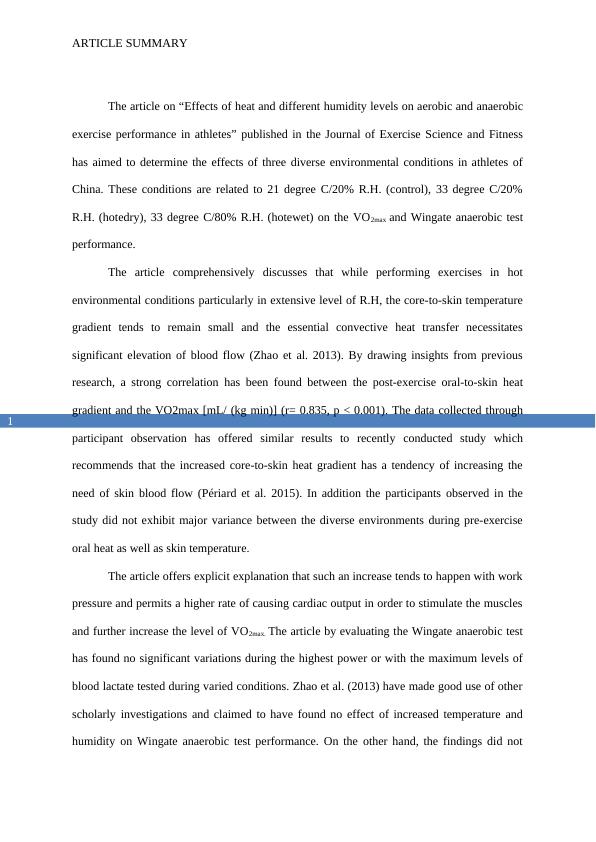Article Summary - Effects of Heat and Humidity Levels on Aerobic and Anaerobic Exercise
Added on 2022-09-08
4 Pages594 Words19 Views
Running head: ARTICLE SUMMARY
ARTICLE SUMMARY
Name of the Student:
Name of the University:
Author note:
ARTICLE SUMMARY
Name of the Student:
Name of the University:
Author note:

1
ARTICLE SUMMARY
The article on “Effects of heat and different humidity levels on aerobic and anaerobic
exercise performance in athletes” published in the Journal of Exercise Science and Fitness
has aimed to determine the effects of three diverse environmental conditions in athletes of
China. These conditions are related to 21 degree C/20% R.H. (control), 33 degree C/20%
R.H. (hotedry), 33 degree C/80% R.H. (hotewet) on the VO2max and Wingate anaerobic test
performance.
The article comprehensively discusses that while performing exercises in hot
environmental conditions particularly in extensive level of R.H, the core-to-skin temperature
gradient tends to remain small and the essential convective heat transfer necessitates
significant elevation of blood flow (Zhao et al. 2013). By drawing insights from previous
research, a strong correlation has been found between the post-exercise oral-to-skin heat
gradient and the VO2max [mL/ (kg min)] (r= 0.835, p < 0.001). The data collected through
participant observation has offered similar results to recently conducted study which
recommends that the increased core-to-skin heat gradient has a tendency of increasing the
need of skin blood flow (Périard et al. 2015). In addition the participants observed in the
study did not exhibit major variance between the diverse environments during pre-exercise
oral heat as well as skin temperature.
The article offers explicit explanation that such an increase tends to happen with work
pressure and permits a higher rate of causing cardiac output in order to stimulate the muscles
and further increase the level of VO2max. The article by evaluating the Wingate anaerobic test
has found no significant variations during the highest power or with the maximum levels of
blood lactate tested during varied conditions. Zhao et al. (2013) have made good use of other
scholarly investigations and claimed to have found no effect of increased temperature and
humidity on Wingate anaerobic test performance. On the other hand, the findings did not
ARTICLE SUMMARY
The article on “Effects of heat and different humidity levels on aerobic and anaerobic
exercise performance in athletes” published in the Journal of Exercise Science and Fitness
has aimed to determine the effects of three diverse environmental conditions in athletes of
China. These conditions are related to 21 degree C/20% R.H. (control), 33 degree C/20%
R.H. (hotedry), 33 degree C/80% R.H. (hotewet) on the VO2max and Wingate anaerobic test
performance.
The article comprehensively discusses that while performing exercises in hot
environmental conditions particularly in extensive level of R.H, the core-to-skin temperature
gradient tends to remain small and the essential convective heat transfer necessitates
significant elevation of blood flow (Zhao et al. 2013). By drawing insights from previous
research, a strong correlation has been found between the post-exercise oral-to-skin heat
gradient and the VO2max [mL/ (kg min)] (r= 0.835, p < 0.001). The data collected through
participant observation has offered similar results to recently conducted study which
recommends that the increased core-to-skin heat gradient has a tendency of increasing the
need of skin blood flow (Périard et al. 2015). In addition the participants observed in the
study did not exhibit major variance between the diverse environments during pre-exercise
oral heat as well as skin temperature.
The article offers explicit explanation that such an increase tends to happen with work
pressure and permits a higher rate of causing cardiac output in order to stimulate the muscles
and further increase the level of VO2max. The article by evaluating the Wingate anaerobic test
has found no significant variations during the highest power or with the maximum levels of
blood lactate tested during varied conditions. Zhao et al. (2013) have made good use of other
scholarly investigations and claimed to have found no effect of increased temperature and
humidity on Wingate anaerobic test performance. On the other hand, the findings did not

End of preview
Want to access all the pages? Upload your documents or become a member.
Related Documents
Dehydration Effects on Bowling Speed, Point of Release and Ball Pitchinglg...
|11
|3044
|244
